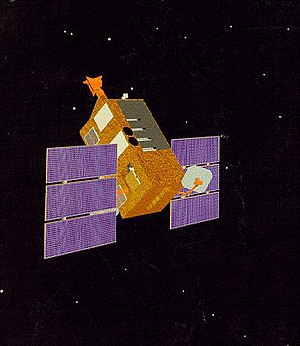
Back مسبار روسي لتوقيت الأشعة السينية Arabic Rossi X-ray Timing Explorer Czech Rossi X-ray Timing Explorer German Rossi X-ray Timing Explorer Spanish کاوشگر زمانسنج پرتو ایکس روسی Persian Rossi X-ray Timing Explorer Finnish Rossi X-ray Timing Explorer French Rossi X-ray Timing Explorer Galician RXTE HE Rossi X-ray Timing Explorer ID
 Rossi X-ray Timing Explorer satellite | |||||||
| Names | Explorer 69 RXTE XTE | ||||||
|---|---|---|---|---|---|---|---|
| Mission type | Astronomy | ||||||
| Operator | NASA | ||||||
| COSPAR ID | 1995-074A | ||||||
| SATCAT no. | 23757 | ||||||
| Website | RXTE home page | ||||||
| Mission duration | 16 years (achieved) | ||||||
| Spacecraft properties | |||||||
| Spacecraft | Explorer LXVIX | ||||||
| Spacecraft type | Rossi X-ray Timing Explorer | ||||||
| Bus | X-ray Timing Explorer | ||||||
| Manufacturer | Goddard Space Flight Center | ||||||
| Launch mass | 3,200 kg (7,100 lb) | ||||||
| Power | 800 watts | ||||||
| Start of mission | |||||||
| Launch date | 30 December 1995, 13:48:00 UTC | ||||||
| Rocket | Delta II 7920-10 (Delta 230) | ||||||
| Launch site | Cape Canaveral, SLC-17A | ||||||
| Contractor | McDonnell Douglas Astronautics Company | ||||||
| Entered service | 30 December 1995 | ||||||
| End of mission | |||||||
| Deactivated | 12 January 2012 | ||||||
| Decay date | 30 April 2018 [1] | ||||||
| Orbital parameters | |||||||
| Reference system | Geocentric orbit[2] | ||||||
| Regime | Low Earth orbit | ||||||
| Perigee altitude | 409 km (254 mi) | ||||||
| Apogee altitude | 409 km (254 mi) | ||||||
| Inclination | 28.50° | ||||||
| Period | 92.60 minutes | ||||||
| Instruments | |||||||
| |||||||
The Rossi X-ray Timing Explorer (RXTE) was a NASA satellite that observed the time variation of astronomical X-ray sources, named after physicist Bruno Rossi. The RXTE had three instruments — an All Sky Monitor, the High-Energy X-ray Timing Experiment (HEXTE) and the Proportional Counter Array. The RXTE observed X-rays from black holes, neutron stars, X-ray pulsars and X-ray bursts. It was funded as part of the Explorer program, and was also called Explorer 69.
RXTE had a mass of 3,200 kg (7,100 lb) and was launched from Cape Canaveral on 30 December 1995, at 13:48:00 UTC, on a Delta II launch vehicle. Its International Designator is 1995-074A.[3]
- ^ "NASA's Rossi X-ray Timing Explorer Leaves Scientific "Treasure Trove"". NASA. May 2018. Retrieved 3 May 2018.
 This article incorporates text from this source, which is in the public domain.
This article incorporates text from this source, which is in the public domain.
- ^ "Trajectory: X-Ray Timing Explorer (1995-074A) Explorer 69". NASA. 28 October 2021. Retrieved 28 November 2021.
 This article incorporates text from this source, which is in the public domain.
This article incorporates text from this source, which is in the public domain.
- ^ "Display: X-Ray Timing Explorer (1995-074A) Explorer 69". NASA. 28 October 2021. Retrieved 28 November 2021.
 This article incorporates text from this source, which is in the public domain.
This article incorporates text from this source, which is in the public domain.
© MMXXIII Rich X Search. We shall prevail. All rights reserved. Rich X Search